Wood and wire fencing brings together rustic charm and practical durability. These fences look great, keep pets safe, and protect gardens. Plus, they won’t break the bank and you can customize them in all kinds of ways.
Maybe you want privacy, maybe it’s security, or maybe you’re just after some character for your outdoor space.
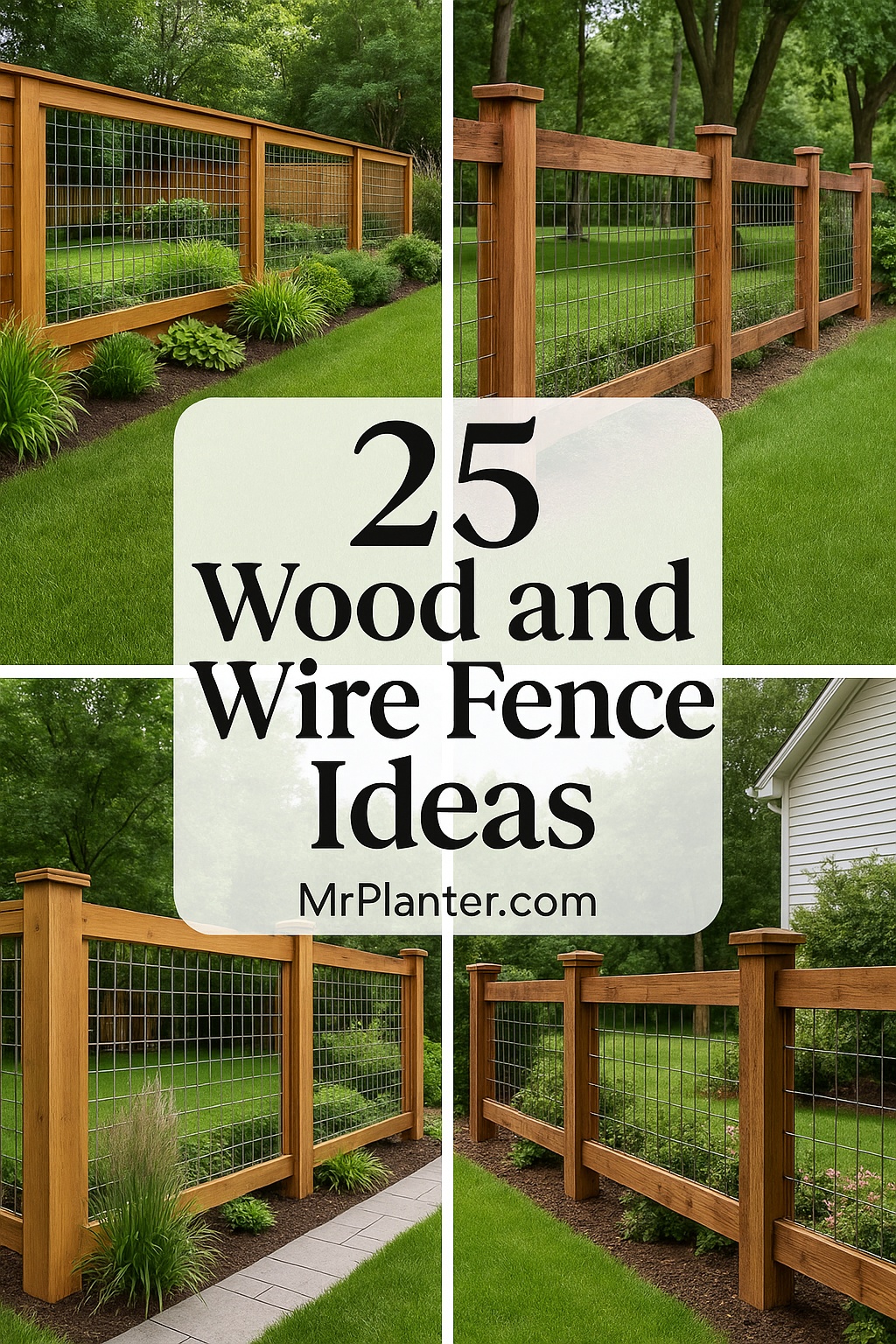
These creative combos might just spark your next project and help you build something a little out of the ordinary.
1. Classic Horizontal Slat with Welded Wire

This design uses horizontal cedar planks spaced evenly, with galvanized welded wire mesh stretched between sturdy wooden posts. You get clean lines, visibility, and good airflow.
Stain the wood in natural tones or paint it to match your house—totally up to you. The wire mesh keeps small animals out but lets the light shine through. It’s a style that fits right in for front yards or backyard gardens, and honestly, it gives off a modern farmhouse vibe that works with almost any landscape.
Expert Tip from MrPlanter: “Use 2×4 pressure-treated posts set 8 feet apart and attach 1×6 cedar boards horizontally for maximum stability. Apply a clear wood sealant annually to maintain that fresh, natural look.”
2. Rustic Split Rail with Chicken Wire
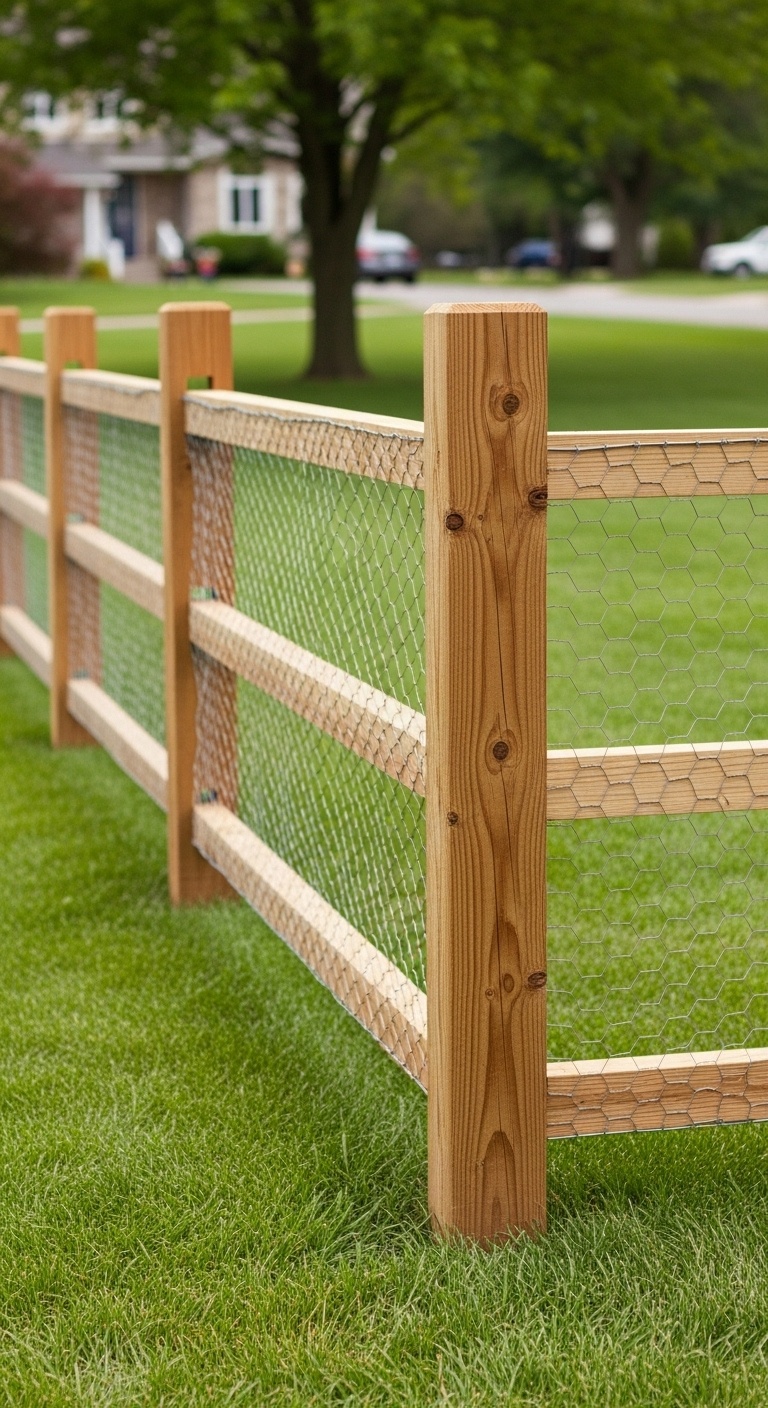
Give the classic split rail fence a twist by adding chicken wire between the rails for a cozy country feel. Rough-hewn wooden posts and rails create pockets for the galvanized chicken wire, and the look is both practical and kind of charming.
Let the wood weather naturally or add a light stain to bring out the grain. It’s a great fit for vegetable gardens, flower beds, or just as a decorative property line.
Expert Tip from MrPlanter: “Staple the chicken wire to the inside of the fence facing your property to prevent sagging over time. Use fence stretchers to ensure the wire stays taut and professional-looking.”
3. Modern Vertical Board and Wire Grid
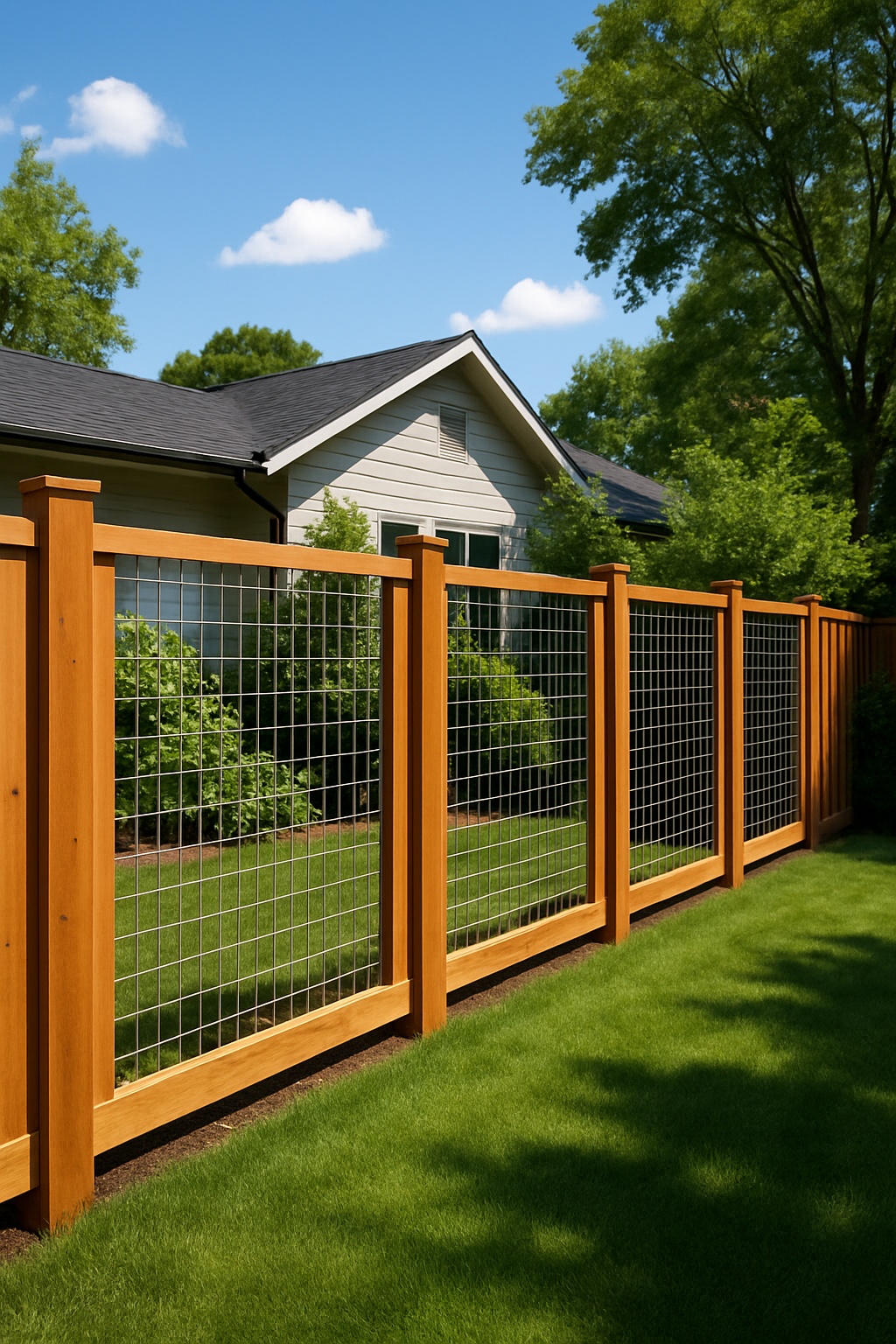
Go for a contemporary look with vertical cedar boards and square wire mesh panels in between. The evenly spaced slats and 4-inch wire grids create sharp geometric patterns.
Vertical lines make spaces feel taller, and the grid keeps things open and breezy. You can mix up the width of the boards or keep them all the same for a more organized look. Try bold paint colors or leave the wood natural—either way, it fits modern homes really well.
Expert Tip from MrPlanter: “Choose 16-gauge welded wire mesh for durability and use galvanized carriage bolts to secure panels to posts. This prevents rust stains and ensures your fence stays beautiful for years.”
4. Diagonal Lattice with Hardware Cloth

Bring some architectural flair with diagonal wooden lattice and fine hardware cloth mesh. Diamond-shaped openings get filled with quarter-inch hardware cloth, which keeps out small critters while letting air flow through.
The diagonal pattern draws your eye up and creates shifting shadows as the day goes on. Build it in sections for easier install and repairs. The fine mesh is great for gardens, especially if you’re battling rabbits or other tiny pests.
Expert Tip from MrPlanter: “Cut your lattice strips at precise 45-degree angles and use wood glue plus galvanized screws for joints that won’t separate. Pre-drill all screw holes to prevent splitting the thin lattice wood.”
5. Bamboo Screen with Cable Wire

Mix sustainable bamboo screens with tensioned cable wire for an eco-friendly fence. Bamboo panels attach to wooden posts, and horizontal cables run between them for extra security.
Bamboo gives you privacy and texture, while cable wire adds a modern, industrial edge. Roll up sections for parties or leave them fixed for full-time screening. Works especially well around pools or patios if you want a flexible, Asian-inspired look.
Expert Tip from MrPlanter: “Use marine-grade stainless steel cable and turnbuckles for tensioning systems that won’t rust or corrode. Apply bamboo oil annually to prevent cracking and maintain the natural golden color.”
6. Picket Fence with Decorative Wire Panels
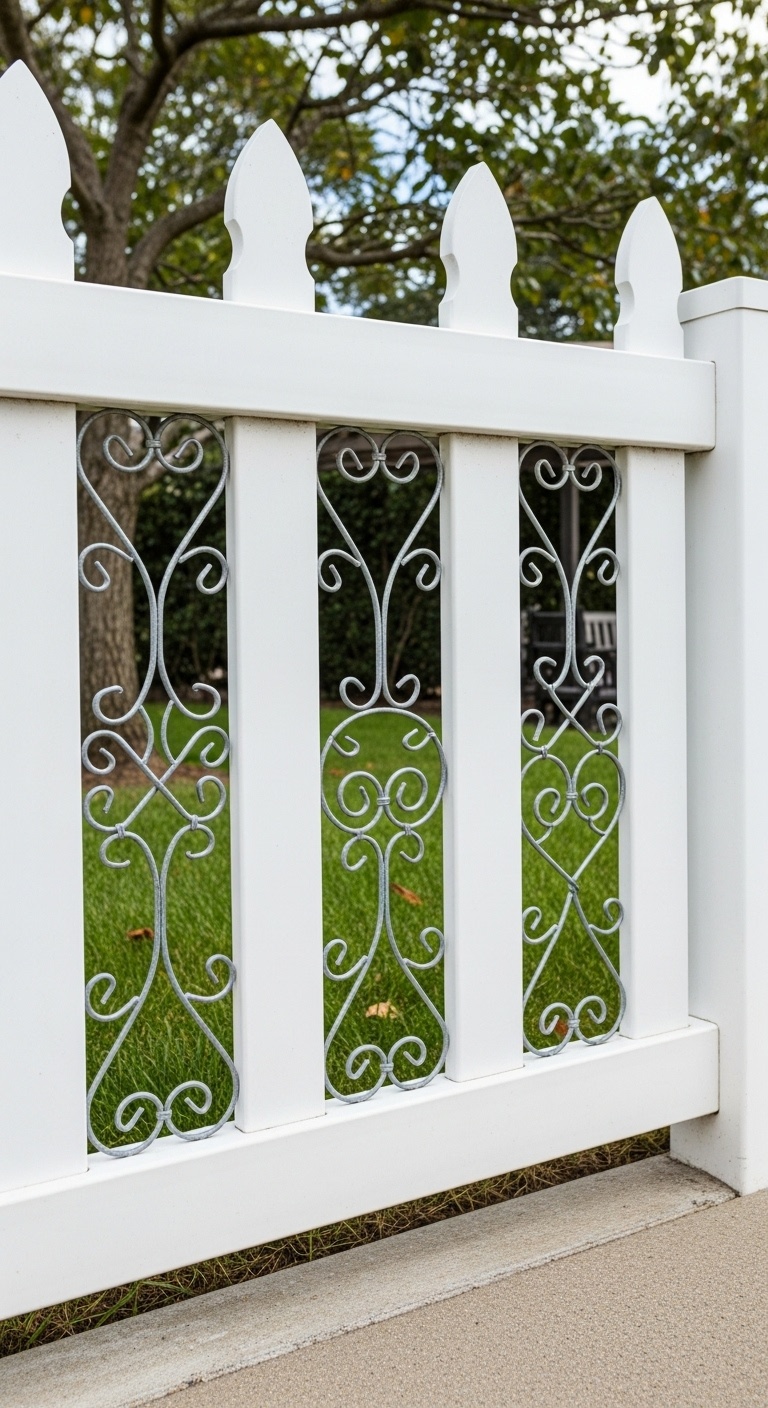
Give the classic white picket fence a boost by adding ornate wire panels between sections. Pointed pickets team up with decorative wrought iron or powder-coated steel panels to create eye-catching focal points.
You can pick from scrollwork, geometric shapes, or even floral patterns for the wire. It’s a perfect fit for front yards or garden entries if you want to blend cottage charm with a touch of artistry.
Expert Tip from MrPlanter: “Paint both wood and metal components with the same high-quality exterior paint for a cohesive look. Use rust-inhibiting primer on all metal parts before applying the topcoat.”
7. Cedar Post and Panel with Hogwire
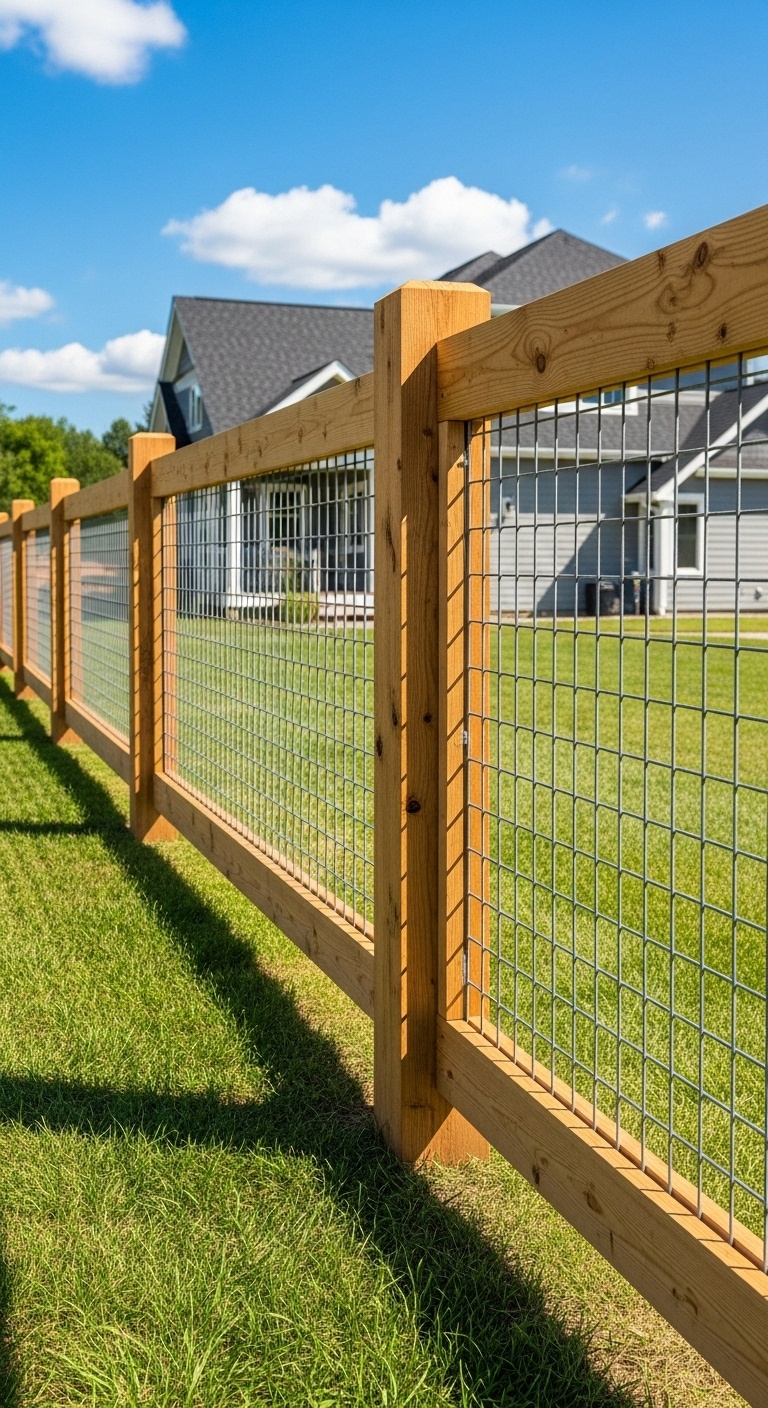
Go ranch-style with cedar posts and hogwire mesh panels for a genuine western vibe. Thick cedar posts and horizontal rails hold rectangular hogwire mesh, and you can pick mesh sizes to suit your needs.
Over time, cedar weathers to a gorgeous silver-gray. The galvanized wire keeps doing its job, whether you’re fencing a garden or a livestock area. It’s a solid choice for rural themes and wide-open spaces where you still want a clear view.
Expert Tip from MrPlanter: “Set cedar posts 24 inches deep in concrete for stability and use galvanized bolts to attach rails. Choose 12.5-gauge hogwire for maximum durability without sacrificing the authentic ranch appearance.”
8. Scalloped Edge with Chain Link Insert
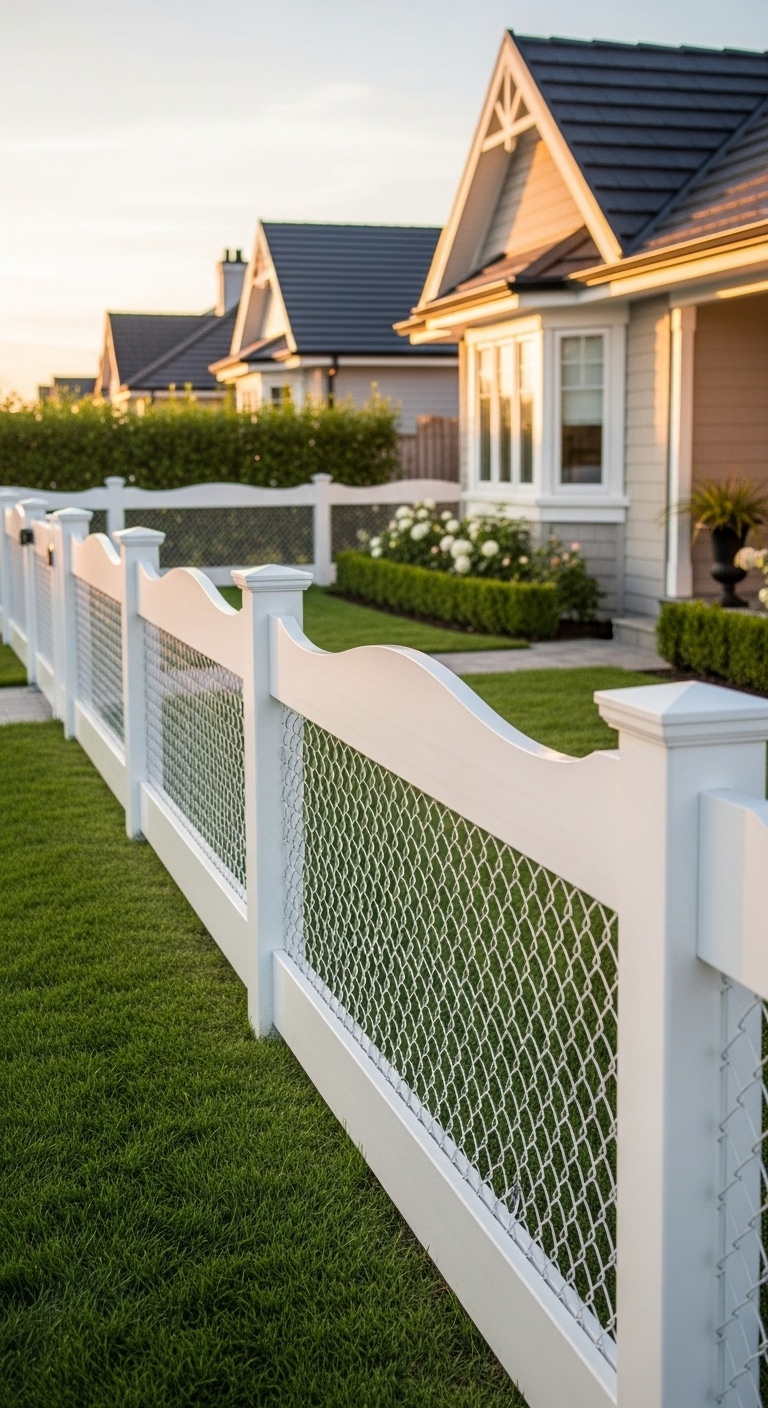
Add a playful touch with scalloped wooden edges and chain link mesh inserts. Decorative curves along the top rail combine with chain link mesh stretched between wooden frames for a fence that’s both fun and secure.
You can go bold with paint or keep it all-natural. This style works for playgrounds, pet runs, or any spot where you want a little whimsy without losing function.
Expert Tip from MrPlanter: “Use a flexible curve ruler or large compass to mark consistent scallop patterns before cutting. Sand all cut edges smooth and apply extra primer to prevent moisture absorption.”
9. Shadow Box with Wire Mesh Backing
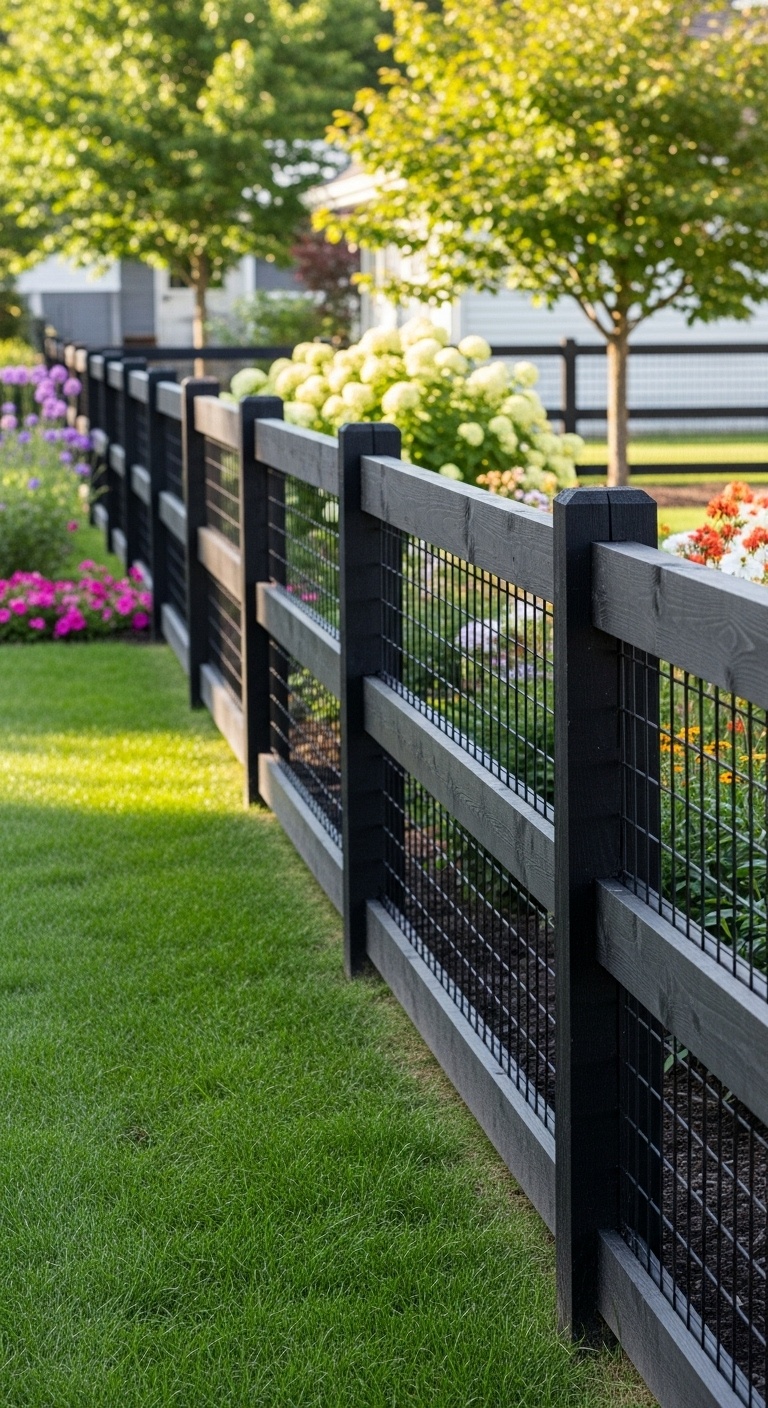
Get privacy with personality by building a shadow box fence with wire mesh backing. Boards alternate on both sides, and wire mesh runs behind them for extra security.
The shadow box style hides your yard from most angles but still lets in some light and air. Adjust the gaps between boards to play with privacy and shadows. The wire mesh keeps things secure, even if someone tries to peek through the cracks.
Expert Tip from MrPlanter: “Install the wire mesh first, then attach boards to ensure consistent spacing and prevent sagging. Use 1×6 cedar boards with 2-inch gaps for optimal privacy while maintaining airflow.”
10. Japanese-Style Bamboo with Tension Wire

Go zen with a fence made from bamboo poles and tensioned wire. Vertical bamboo poles with horizontal wires for crisp, modern lines.
The bamboo brings a natural, calming vibe, and the wires keep everything tidy. Arrange the poles in patterns or space them randomly for a more relaxed look. It’s a peaceful choice for meditation gardens or water features.
Expert Tip from MrPlanter: “Treat bamboo poles with boric acid solution before installation to prevent insect damage. Use vinyl-coated aircraft cable for tension wires to prevent cutting or fraying over time.”
11. Board and Batten with Expanded Metal
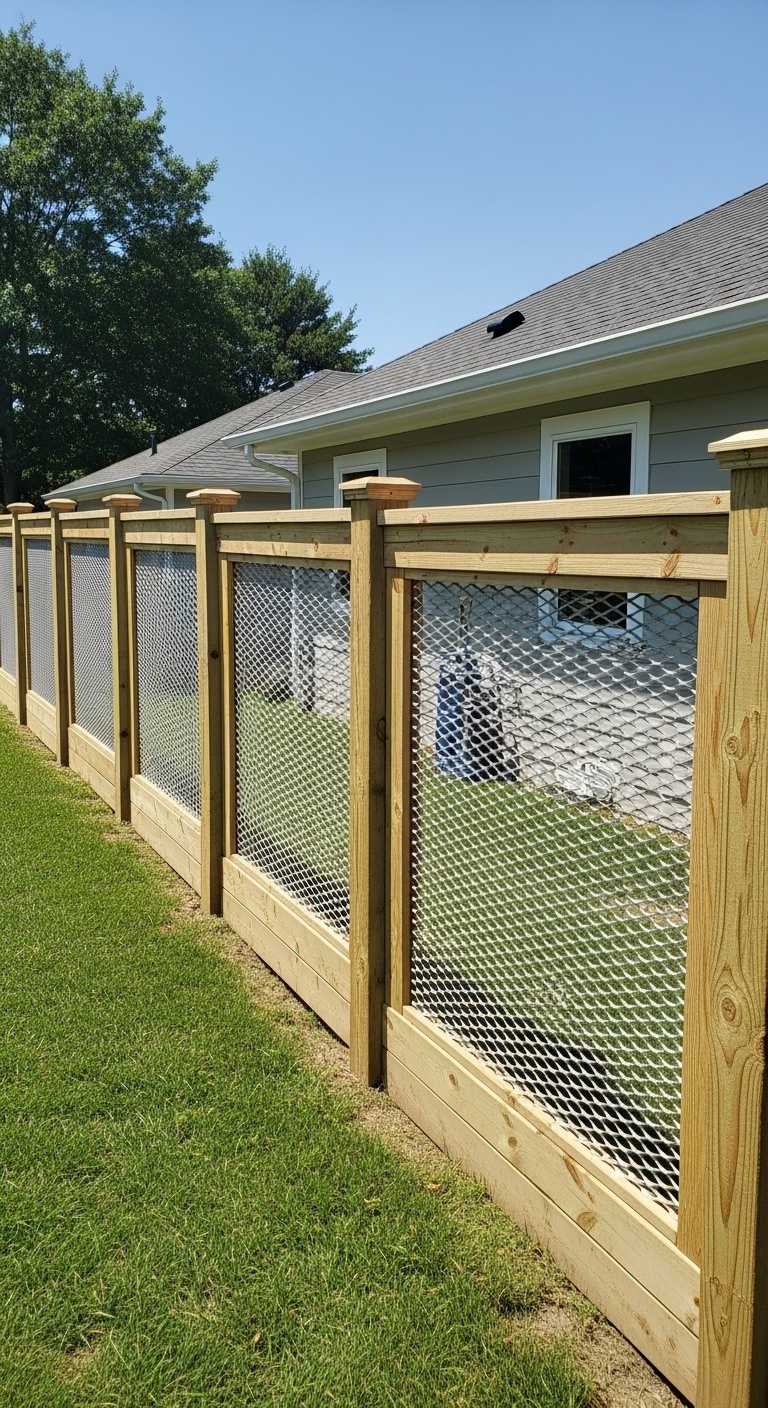
Mix classic board and batten with expanded metal mesh for an industrial-chic fence. Wide boards and narrow battens cover the seams, while expanded metal panels add texture and let air flow through.
You can powder-coat the metal in a color that pops, or keep it raw for a more rugged look. It’s a great fit for modern homes or workshops where you want something a little out of the ordinary.
Expert Tip from MrPlanter: “Choose aluminum expanded metal to prevent rust stains on your wooden components. Use stainless steel screws for all metal attachments to ensure long-lasting connections without corrosion.”
12. Curved Rail with Decorative Wire
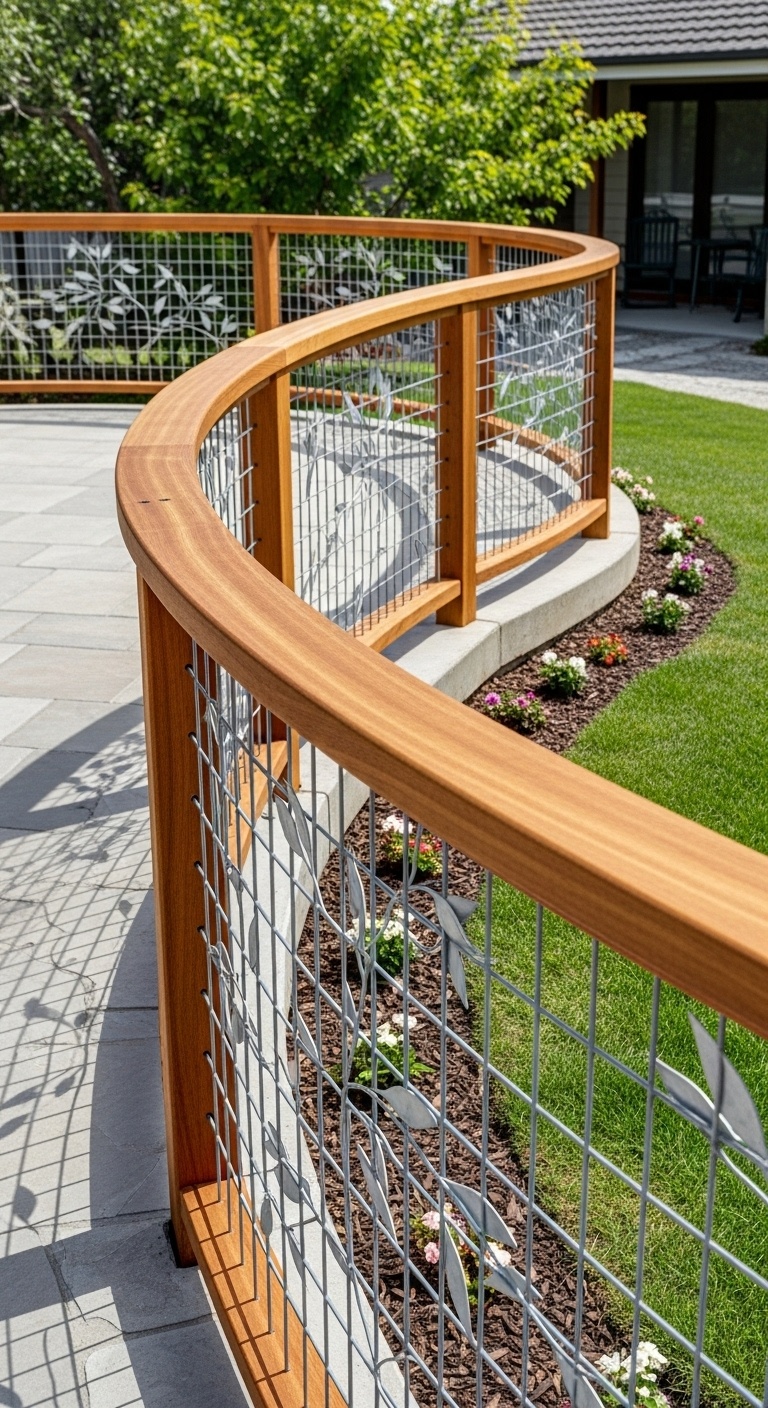
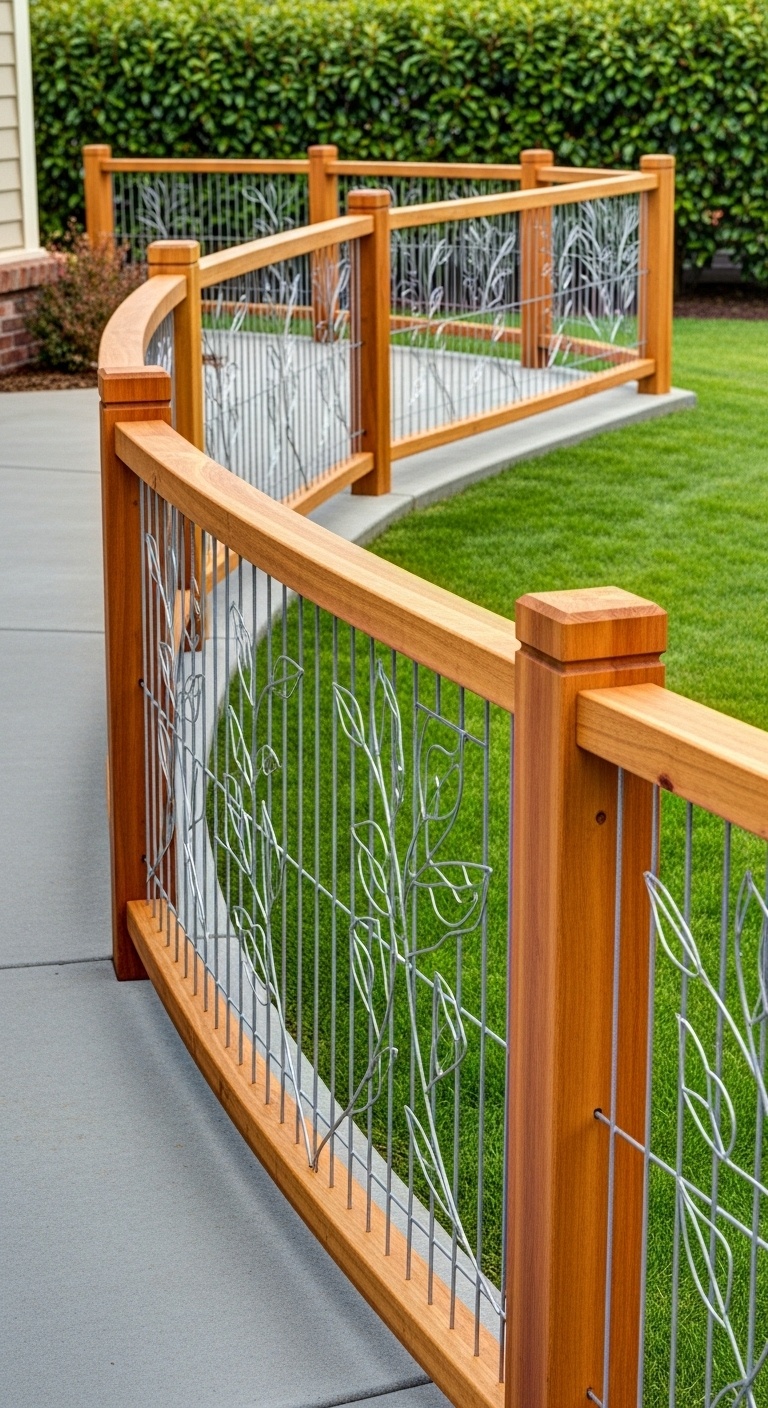
Add gentle curves to your yard with steam-bent wooden rails and ornamental wire panels. The curves soften the fence line, and decorative wire fills the spaces with patterns like leaves or geometric shapes.
This style looks amazing along winding paths or around garden beds. It brings a bit of artistry and movement to your landscape, which is always a plus.
Expert Tip from MrPlanter: “Steam-bend rails while the wood is green for easier shaping and less chance of splitting. Clamp curved pieces to forms until completely dry to maintain their shape permanently.”
13. Rustic Log with Barbed Wire
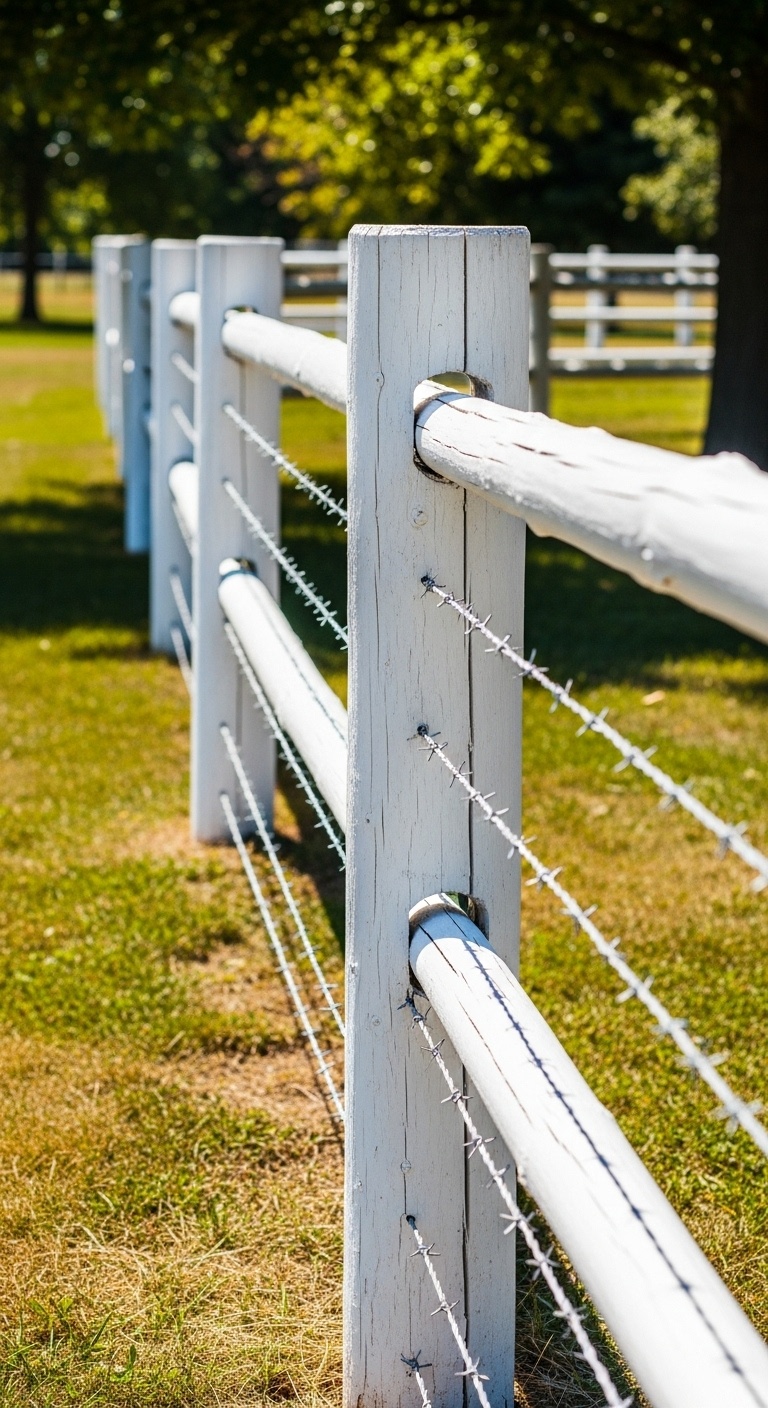
Bring in the wild west with whole logs and traditional barbed wire. Peeled or natural logs serve as posts and rails, while strands of galvanized barbed wire run between for classic ranch vibes.
The logs’ natural imperfections give character, and the barbed wire keeps livestock in check. Pick log sizes and wood species based on what you have or the look you want. It’s an ideal choice for rural properties or horse pastures.
Expert Tip from MrPlanter: “Set log posts in gravel-filled holes rather than concrete to allow natural expansion and prevent rot at the base. Use galvanized staples specifically designed for barbed wire to prevent slipping.”
Note: “Check local regulations, as barbed wire may be restricted in some residential areas due to safety concerns. If its restricted you may skip this idea.”
14. Modern Slat with Cable Railing
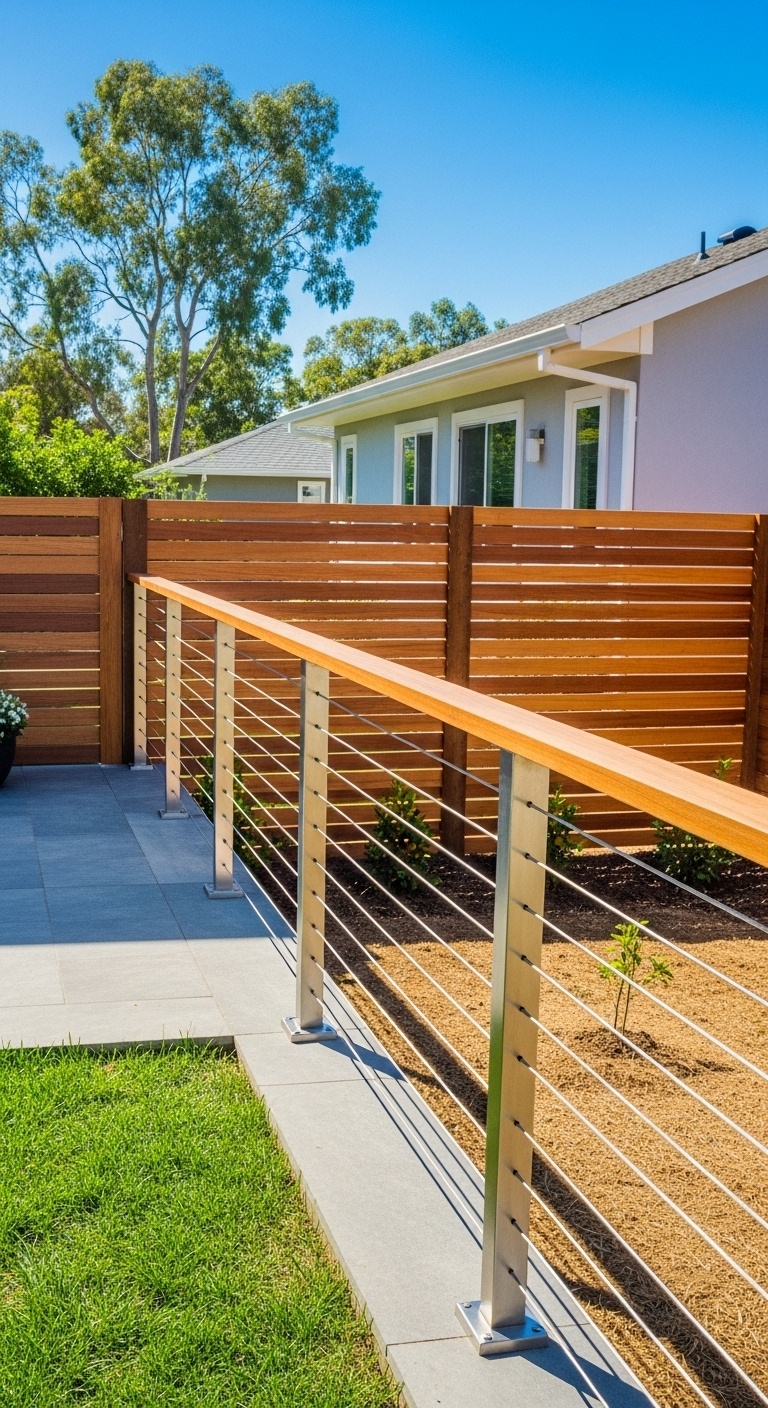
Keep it sleek with horizontal wooden slats and cable railing systems. Precisely spaced slats and thin stainless steel cables give you clean, horizontal lines and a minimalist feel.
Cable systems maintain your view but provide safety—great for decks, balconies, or property lines. Adjust cable spacing to fit local codes. This style really shines for modern homes and city yards where you want something subtle yet striking.
Expert Tip from MrPlanter: “Use a cable tension gauge to ensure consistent tautness across all cables for professional appearance. Install cables before attaching wooden slats to ensure proper alignment and spacing.”
15. Gothic Arch with Wrought Iron Wire
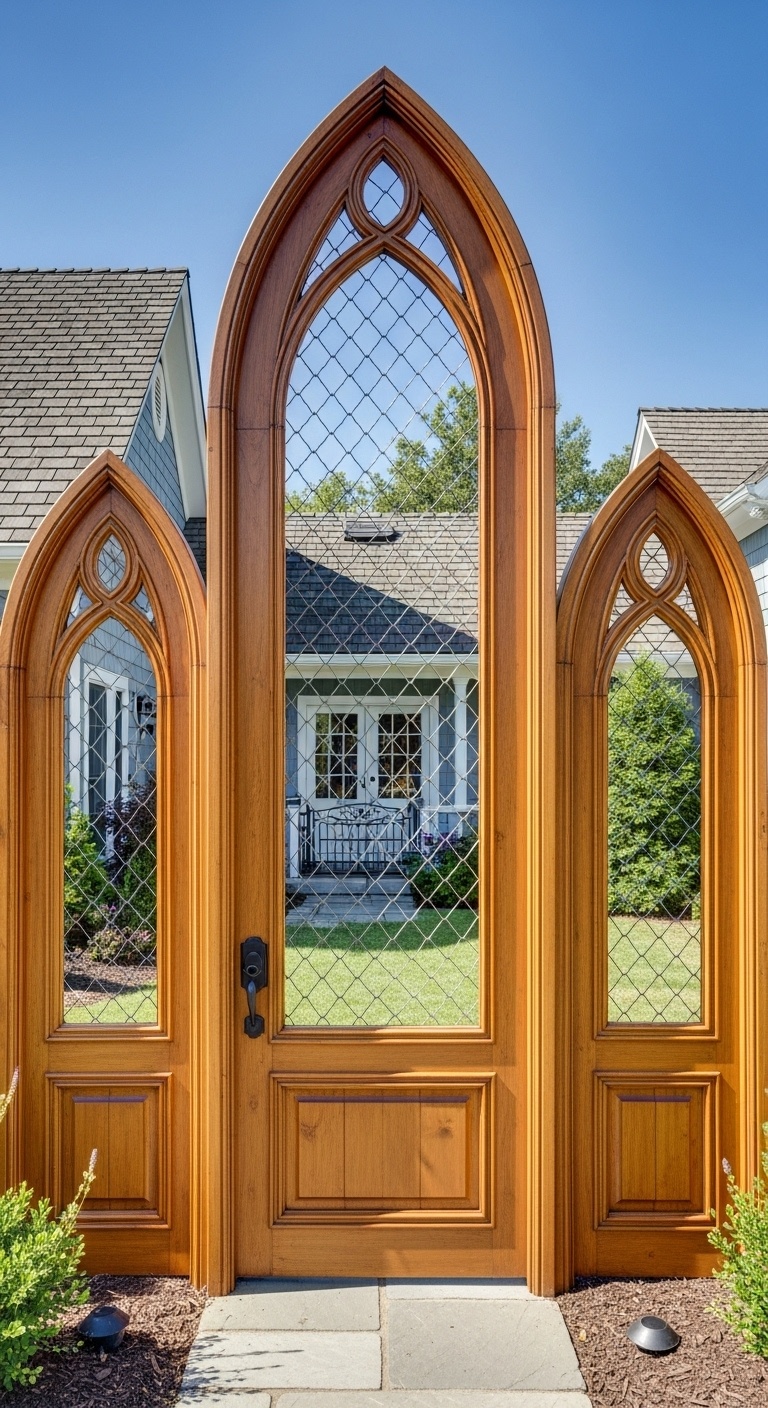
Make a statement with Gothic arch wooden frames and wrought iron wire panels. Pointed arches filled with ornate iron mesh bring medieval romance and some serious drama.
Use multiple arches for a long stretch or just one as a fancy gate. It’s a fantastic look for formal gardens or historic homes if you want to channel a bit of old-world grandeur.
Expert Tip from MrPlanter: “Use a full-size paper template to ensure symmetrical arch curves when cutting wooden frames. Apply rust-preventive primer to all iron components before installation to maintain their appearance.”
16. Tree Branch with Chicken Wire
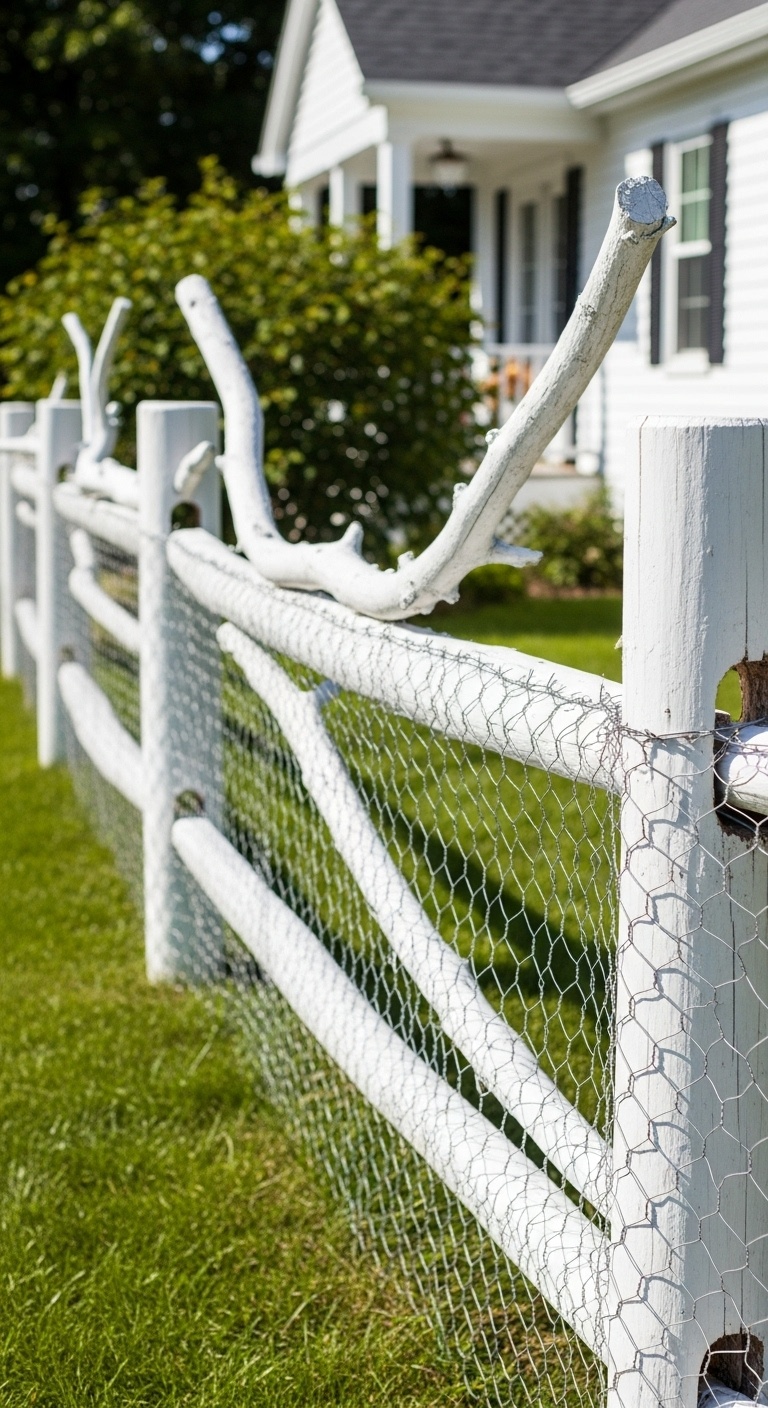
Go all-natural with tree branches and chicken wire for a woodland fence that feels like it belongs. Use fallen or pruned branches woven between posts, and back it up with chicken wire for function.
The irregular shapes and textures make it feel organic, almost wild. Mix up branch sizes or stick to one type for a more uniform look. This fence blends in perfectly with nature preserves or woodland gardens.
Expert Tip from MrPlanter: “Select branches that have been dried for at least six months to prevent excessive shrinkage and pest issues. Secure branches with galvanized wire rather than nails to accommodate natural movement.”
17. Herringbone Pattern with Wire Mesh
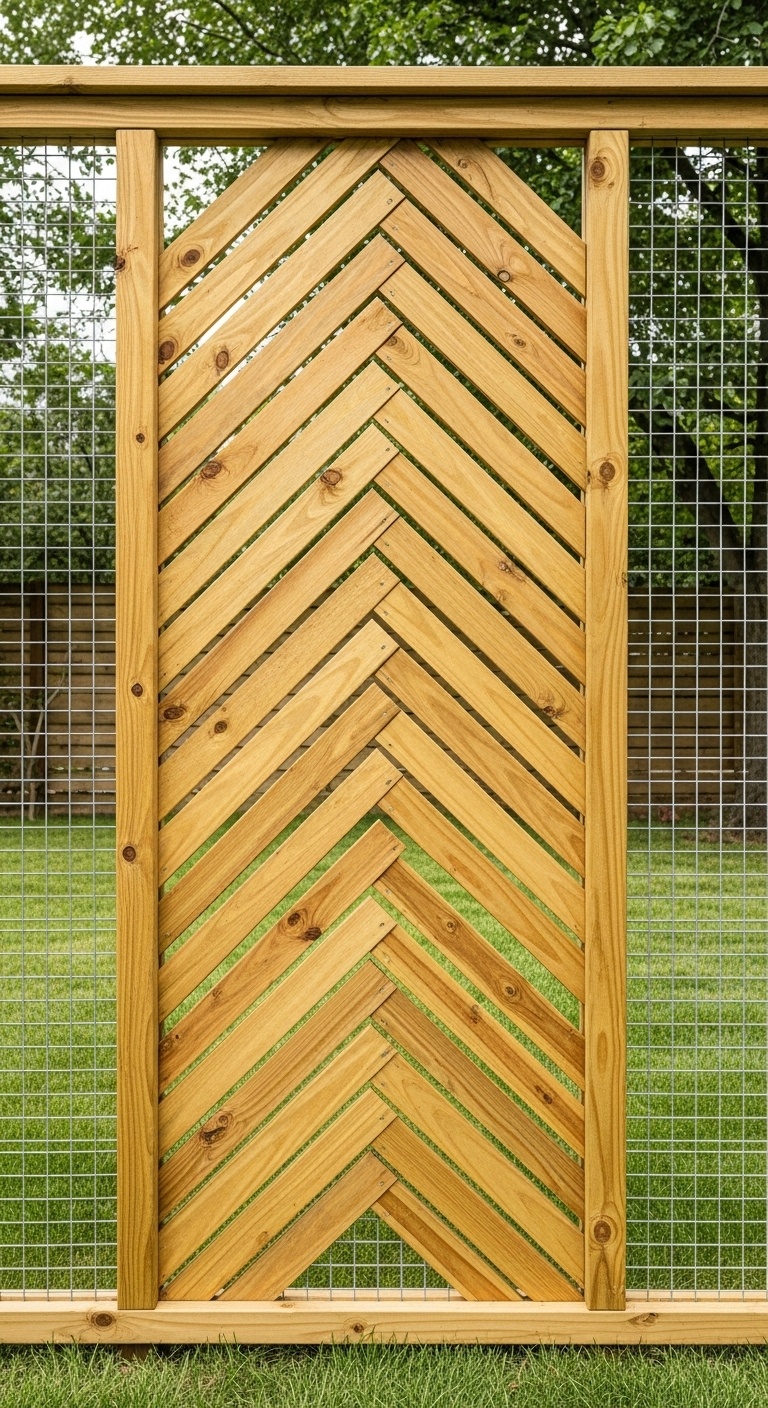
Add a touch of sophistication with herringbone wood patterns and fine wire mesh behind for contrast. Wooden strips arranged in classic herringbone or chevron patterns look sharp, and the mesh adds security.
The angled patterns create visual interest and even trick the eye into making spaces feel bigger. Change up the angle or mix sizes for more complexity. It’s a great option for accent panels or garden screens where you want something a little unexpected.
Expert Tip from MrPlanter: “Cut all herringbone pieces to exact lengths using a miter saw with stop blocks for consistency. Use a chalk line to ensure each row maintains proper alignment during installation.”
18. Live Edge with Hardware Cloth
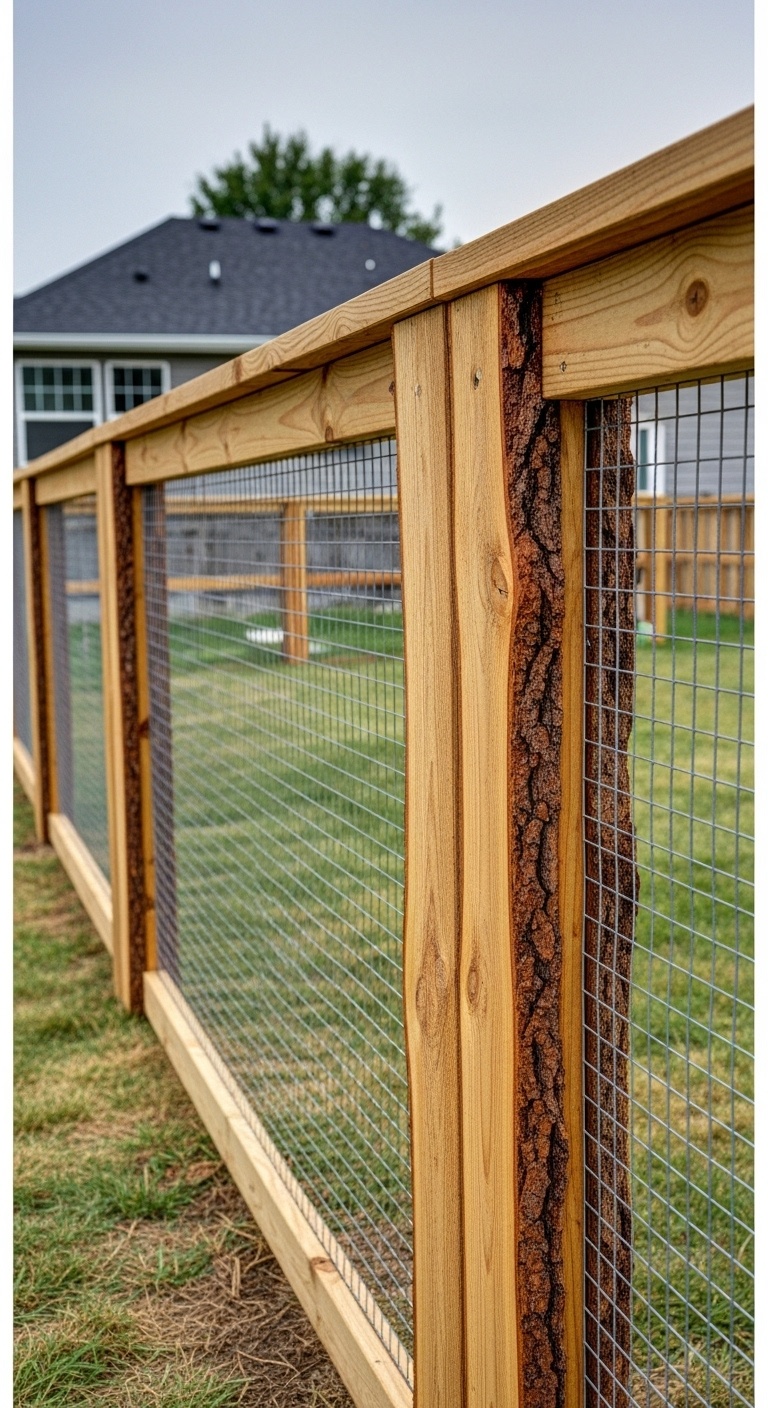
Show off wood’s wild side by pairing live edge boards with sturdy hardware cloth mesh. These boards keep their natural bark edges, so every panel ends up with its own organic shape.
The fine mesh keeps pests out but doesn’t block the view. Live edge boards add rustic charm and really celebrate a tree’s unique growth patterns.
Mix wood species if you want a patchwork look, or stick to one for a more unified vibe. This fence feels right at home in organic gardens or anywhere you want to blur the line between natural and built environments.
Expert Tip from MrPlanter: “Remove loose bark and treat live edges with wood preservative to prevent insect damage and extend life. Use quarter-inch hardware cloth to keep out the smallest garden pests while maintaining visibility.”
19. Chevron Design with Galvanized Wire
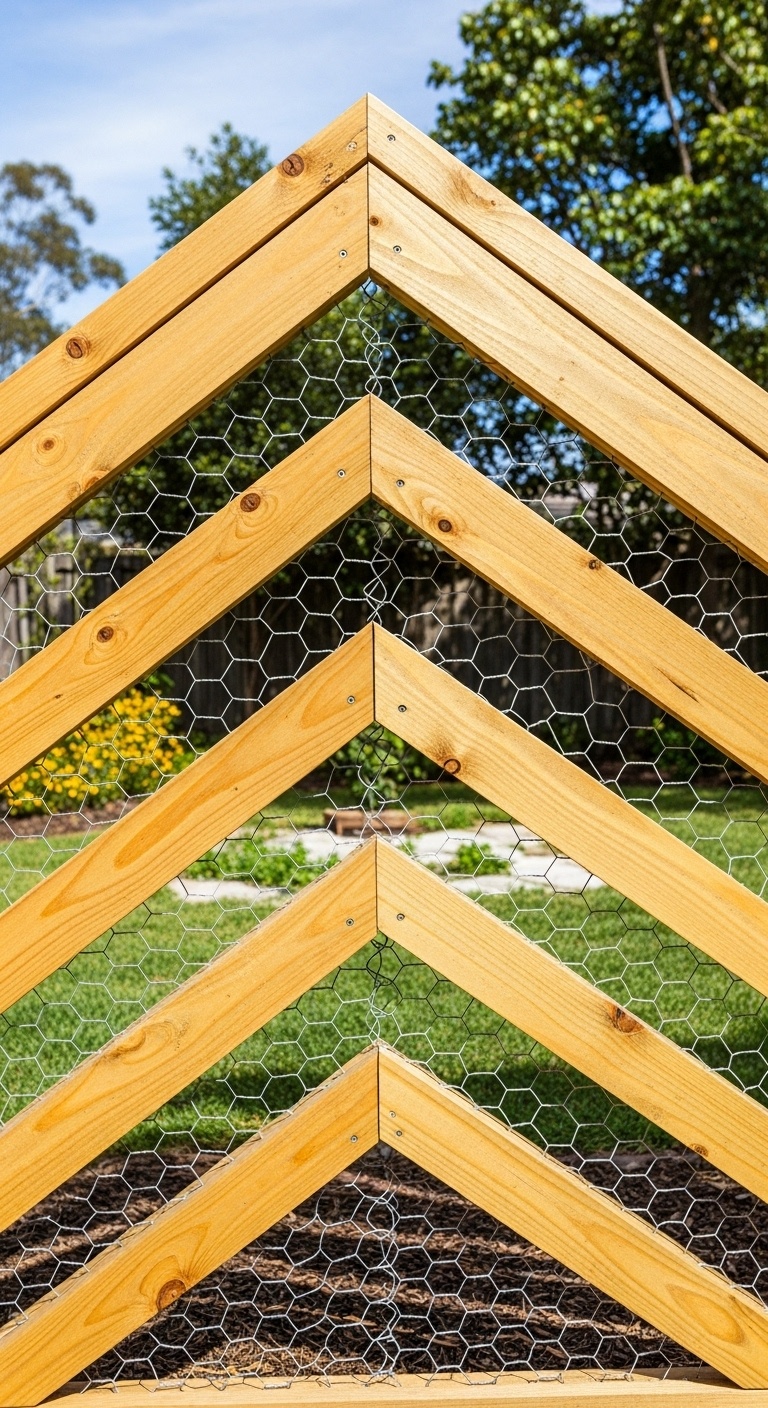
Bring energy to your fence with chevron patterns and galvanized wire mesh. Wooden strips zigzag in sharp angles, and mesh fills the triangles for both style and function.
The chevron pattern adds a sense of movement and direction. Play with the angles for different effects, or combine several for a more complex geometric look.
This style really pops on modern properties or as a bold statement in an art-inspired yard. Sometimes you just want your fence to have a little attitude, right?
Expert Tip from MrPlanter: “Use a speed square to maintain consistent angles when cutting chevron pieces and create a master template for repeated sections. Pre-drill all screw holes to prevent splitting thin wooden strips.”
20. Driftwood Style with Marine Wire
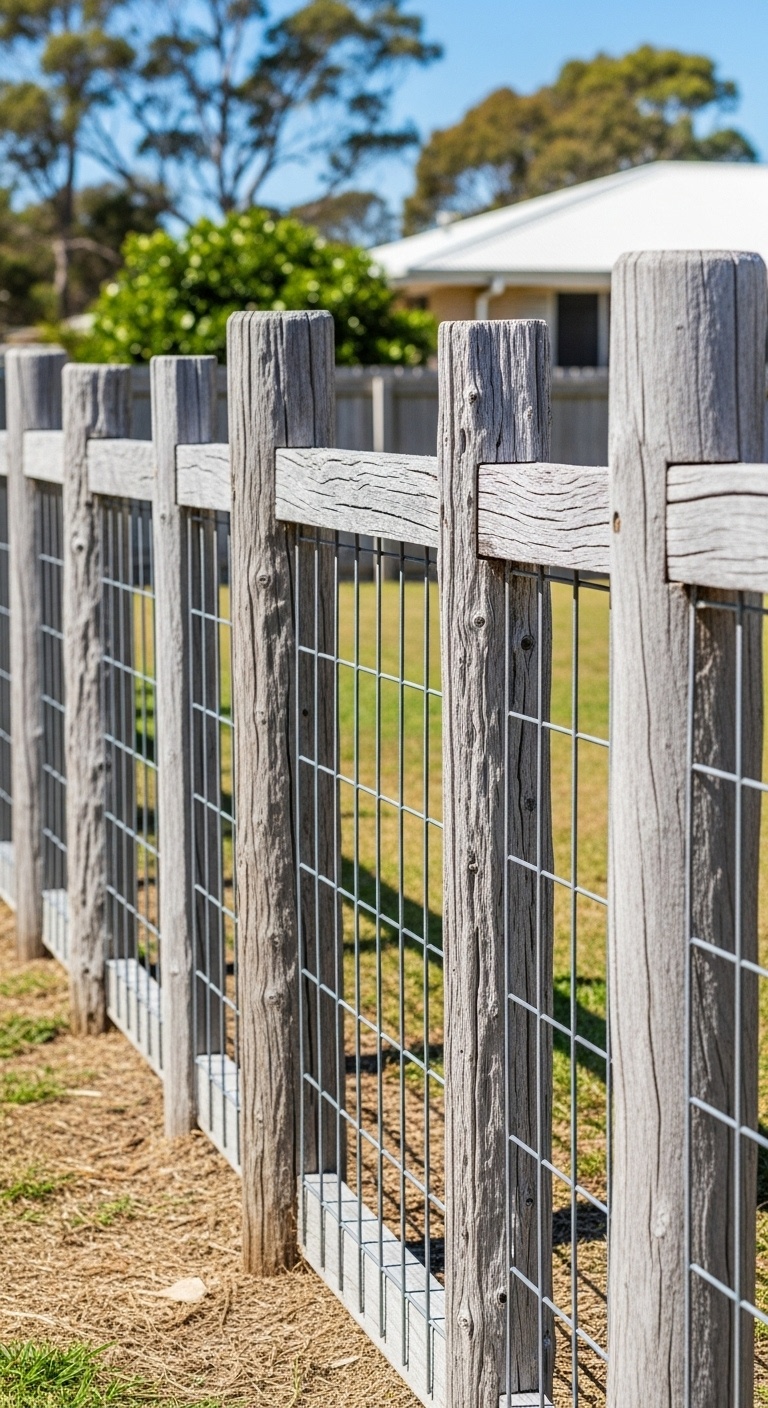
Capture that laid-back coastal vibe with driftwood-style boards and marine-grade wire mesh. The boards get treated or naturally weathered until they look like they washed up on the shore.
Gray, faded wood brings to mind long days by the ocean, and marine wire stands up to salty air. You can fake the driftwood look with stains and sanding, or hunt down the real stuff from old docks or beaches.
This fence feels perfect for beach houses or anyone who wants to bring a little seaside energy inland. Honestly, who doesn’t want a bit of the beach closer to home?
Expert Tip from MrPlanter: “Create authentic weathered appearance using gray wood stain followed by light sanding to reveal underlying wood tones. Choose 316-grade stainless steel wire for ultimate corrosion resistance near saltwater.”
21. Art Deco with Geometric Wire
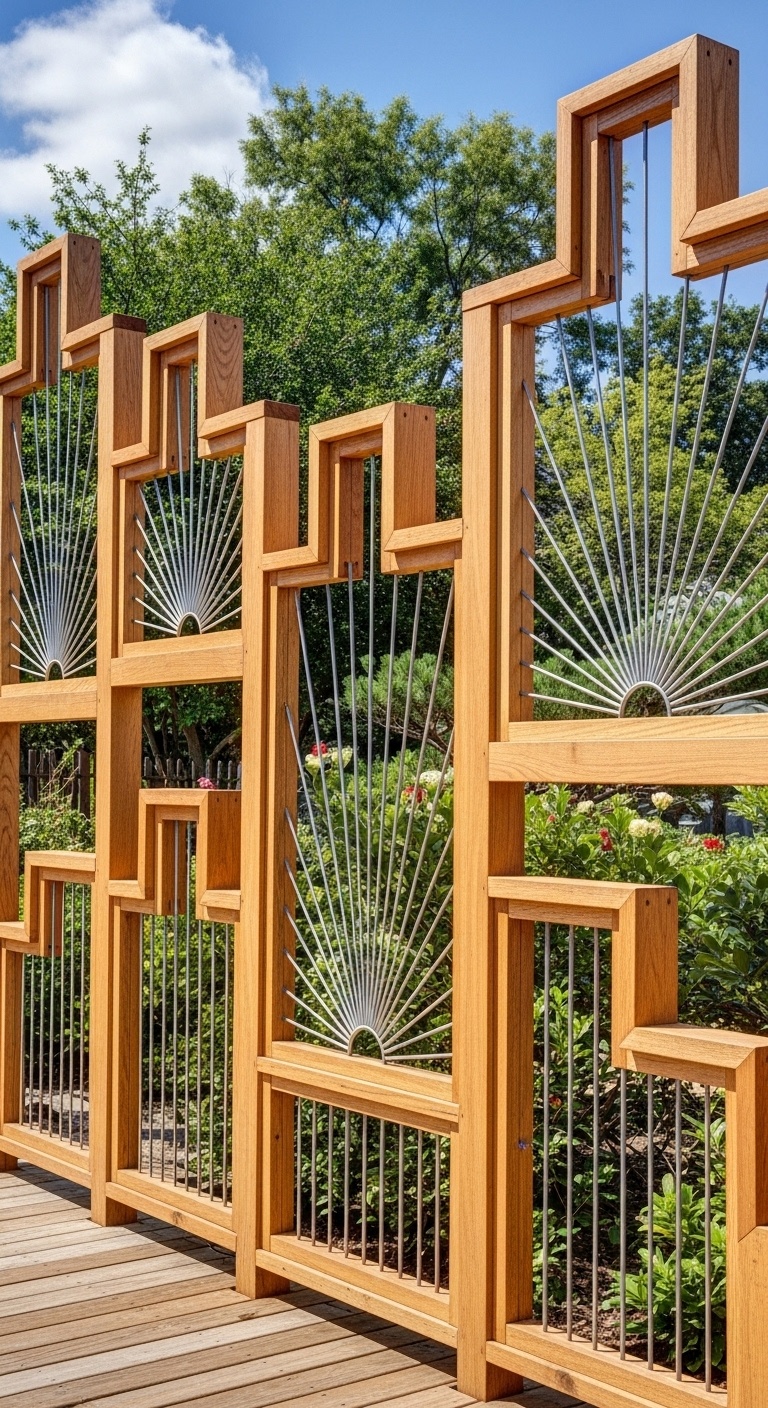
Channel vintage glamour with Art Deco wooden frames and geometric wire patterns. The design uses stepped wood frames inspired by 1920s architecture, paired with wire panels in sunburst, fan, or zigzag shapes.
It’s a little bit fence, a little bit sculpture—definitely not your average boundary. Go bold with powder-coated wire in black, gold, or copper for that period-perfect touch.
This style shines on historic properties or in formal gardens where you want a dash of old-school sophistication. Sometimes, a little extra flair just feels right.
Expert Tip from MrPlanter: “Study authentic Art Deco architectural details for inspiration and use precision templates for cutting geometric wire patterns. Apply multiple thin coats of paint rather than one thick coat for smooth, professional finish.”
22. Rustic Pallet with Hog Panel
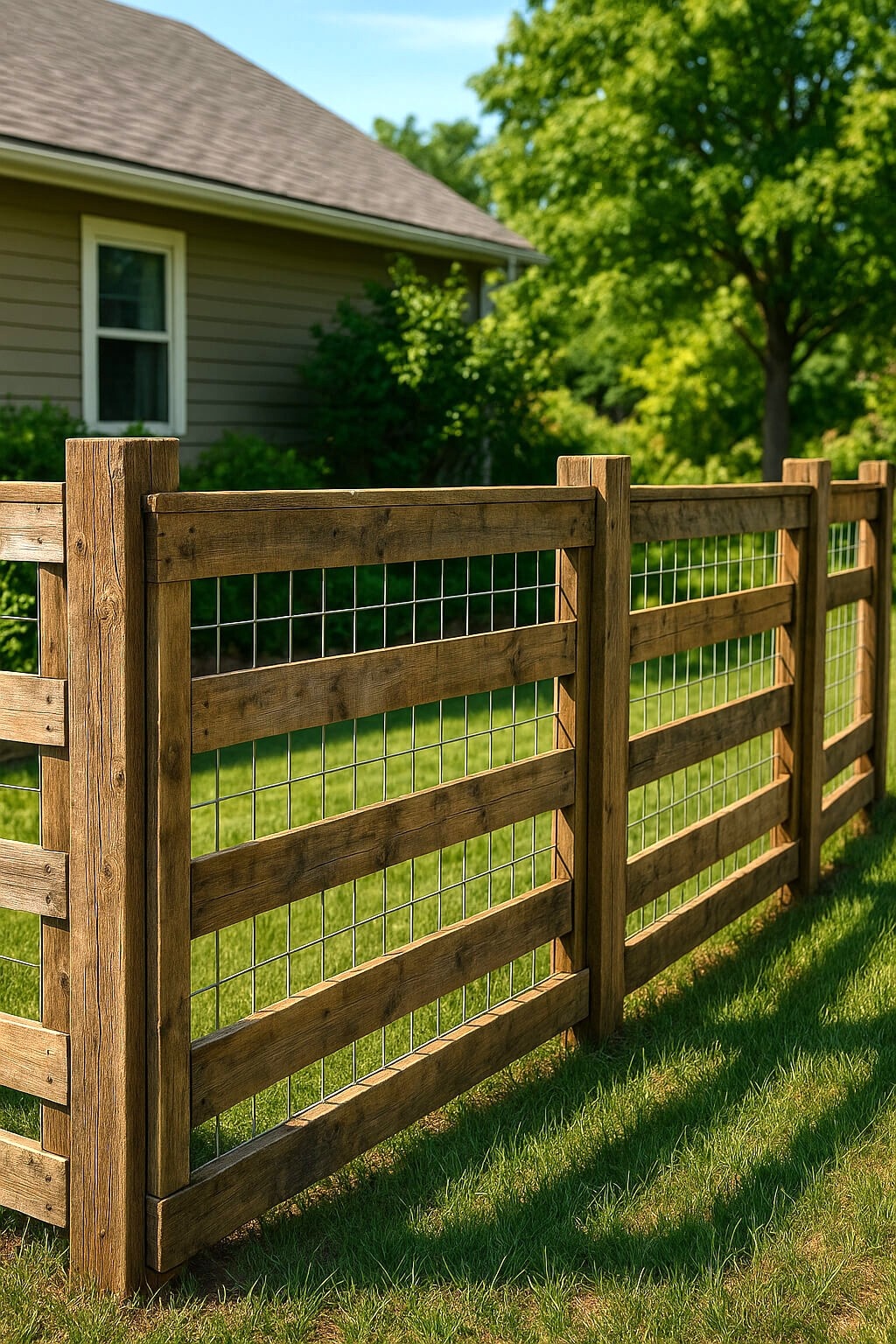
Give old pallets new life by pairing them with hog panel wire for a budget-friendly, sustainable fence. Break down the pallets and rebuild them into fence sections, then back them with tough hog panel wire.
The mix of wood tones and rough textures instantly brings a rustic vibe. Sand and seal the wood for a polished look, or leave it rough for more character—it’s your call.
This fence feels right at home around veggie gardens or chicken coops, especially if you’re watching your budget. Who says practical can’t still look good?
Expert Tip from MrPlanter: “Inspect pallet wood carefully for nails and chemical treatments before use and sand rough surfaces to prevent splinters. Use galvanized hog panels rated for outdoor use to prevent premature rusting.”
23. Contemporary Cube with Wire Inserts
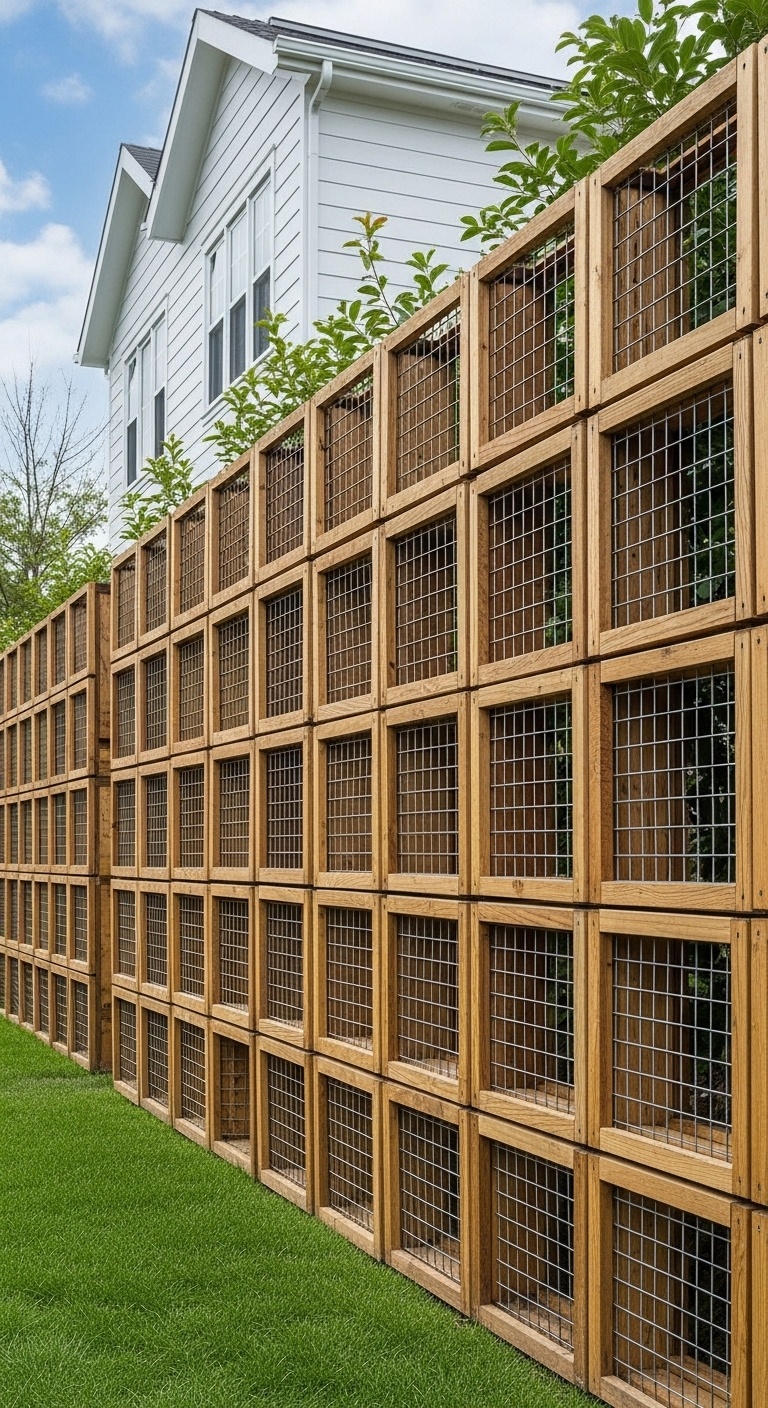
Go modern with cube-shaped wooden frames and wire mesh inserts for a fence that doubles as sculpture. Square frames stack up in geometric patterns, and wire mesh turns the cubes into see-through walls.
The three-dimensional look adds real visual interest, and you can play with cube sizes or layouts to make it your own. This style feels right for contemporary homes or art installations—places where you want your boundaries to make a statement.
Expert Tip from MrPlanter: “Use precision joinery techniques like dado cuts or pocket screws for clean cube construction without visible fasteners. Choose powder-coated welded wire mesh in colors that complement your wooden frames for cohesive appearance.”
24. Victorian Gingerbread with Wire Backing

Add a dash of romance with Victorian gingerbread trim and wire mesh backing for a fence that’s both pretty and secure. Intricate scrollwork and decorative trim sit in front of fine mesh for that classic look.
You can paint the gingerbread in traditional Victorian colors or leave the wood natural for a softer feel. This style fits historic homes and cottage gardens—anywhere you want to channel a bit of old-world charm.
Expert Tip from MrPlanter: “Use a scroll saw for intricate cuts and sand all decorative elements smooth before installation to prevent paint buildup in details. Prime all surfaces thoroughly to prevent moisture absorption in thin decorative pieces.”
25. Mixed Media Artistic with Custom Wire
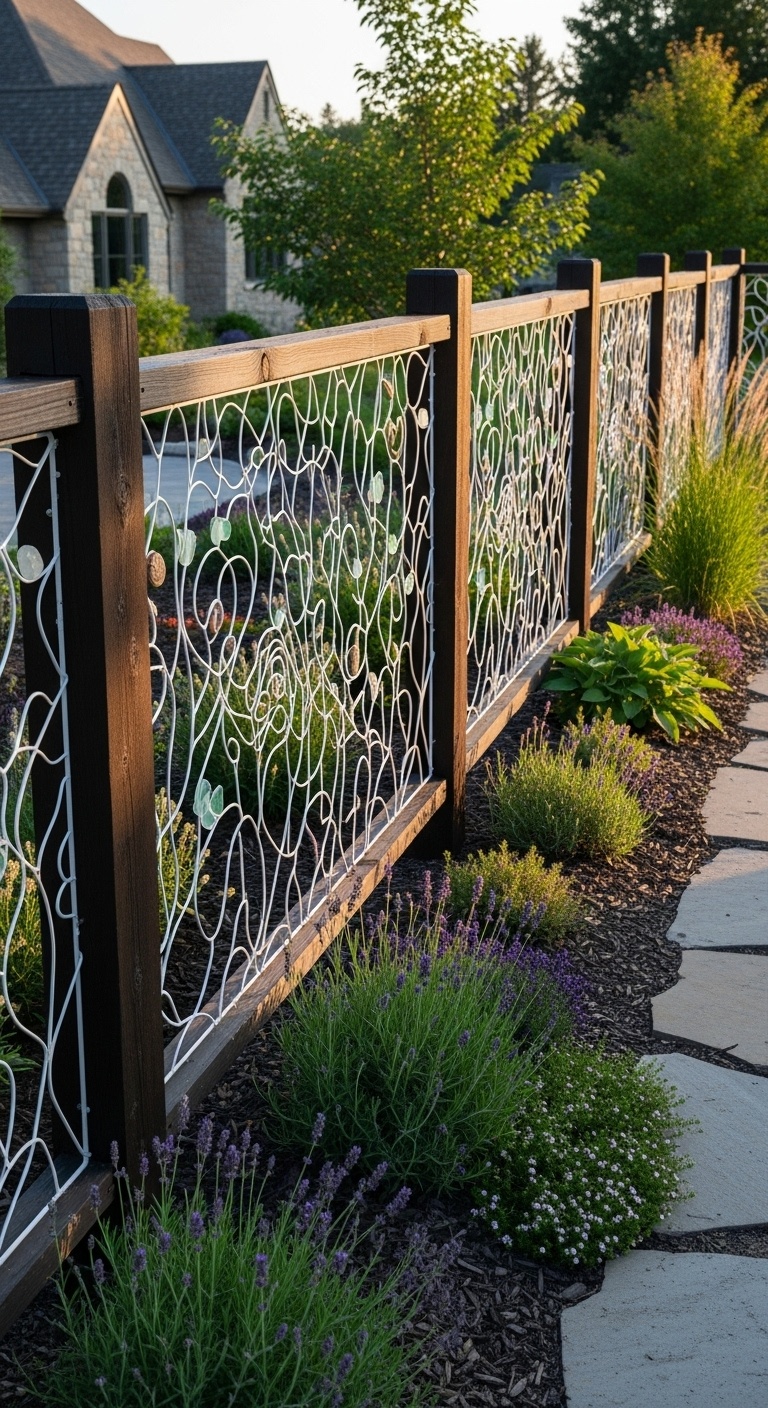
Try designing unique installations by mixing wooden elements with custom wire patterns. You can personalize boundaries in ways that feel totally your own.
This approach blends different wood species, textures, and finishes. Then, you add custom wire work that reflects your style or whatever theme fits your property.
Mixed media techniques open up endless creative options. You still get a fence that works for practical purposes, too.
Why not throw in found objects, recycled bits, or even commissioned metalwork? You’ll end up with something that’s honestly one-of-a-kind.
This kind of fence feels right at home on artistic properties or anywhere you want your boundaries to stand out as landscape art. It’s a great way to let your personality show through.
Expert Tip from MrPlanter: “Plan your mixed media design on paper first to ensure balanced composition and proper proportions before construction. Use compatible finishes across different materials to ensure weather resistance and color consistency over time.”
Of course. Here is the extended value content designed to make your post a comprehensive, go-to resource on the internet for wood and wire fencing. This content transforms it from a simple “idea list” into an actionable, in-depth guide.
The Ultimate Guide to Planning Your Wood and Wire Fence
Feeling inspired? That’s the easy part. Turning that inspiration into a beautiful, durable fence requires a little planning.
A great fence isn’t just about the style; it’s an investment in your property’s value, security, and aesthetic appeal.
This guide will walk you through the crucial considerations before you break ground, ensuring your project is a resounding success.
Step 1: Define Your Fence’s Primary Purpose
Before you fall in love with a specific design, ask yourself: What is the number one job this fence needs to do?
- Privacy: If seclusion is your goal, you’ll want designs with minimal gaps, like the Shadow Box (#9) or Board and Batten (#11), where the wire is more for reinforcement than visibility.
- Security & Pet Containment: For keeping pets in and unwanted critters out, the key is the wire mesh. A Classic Horizontal Slat with Welded Wire (#1) is great for medium-to-large dogs, while the Diagonal Lattice with Hardware Cloth (#4) is essential for keeping out smaller animals like rabbits or protecting a chicken coop. The height of the fence and the size of the mesh openings are your most important variables.
- Garden Protection: The goal here is to deter pests without blocking sunlight. A Rustic Split Rail with Chicken Wire (#2) or the Live Edge with Hardware Cloth (#18) are perfect. They provide a barrier against ground-level threats while allowing maximum light and air circulation for your plants.
- Purely Aesthetic/Decorative: If the fence is meant to define a space or serve as a landscape feature, your options are wide open. Styles like the Gothic Arch (#15), Art Deco (#21), or a simple Cedar Post and Hogwire (#7) can frame a view beautifully without creating a solid barrier.
- Pool Safety: This is non-negotiable. Fences around pools must meet strict local safety codes, which typically dictate a minimum height (often 4-5 feet), non-climbable surfaces, and self-latching gates. A Modern Vertical Board and Wire Grid (#3) can work well, provided the spacing meets regulations.
Step 2: Choosing the Right Materials (A Deeper Dive)
The longevity and look of your fence depend entirely on the materials you choose. Here’s a breakdown to help you decide.
Wood Comparison
| Wood Type | Cost | Lifespan | Maintenance | Best For… |
| Pressure-Treated Pine | $ | 15-20 years | High (Needs regular sealing/staining to prevent warping and rot) | Budget-friendly projects, structural posts that will be hidden or painted. |
| Cedar | $$ | 20-30 years | Medium (Naturally rot and insect-resistant; can be left to weather gray or sealed to retain color) | Posts, rails, and boards where natural beauty and longevity are desired. Classic choice for most fence styles. |
| Redwood | $$$ | 25-35 years | Low (Superior natural resistance to rot, insects, and decay) | High-end, statement fences where budget is less of a concern and you want maximum durability. |
| Bamboo | $$ | 10-15 years | Medium (Requires annual sealing with a specific bamboo oil to prevent splitting) | Unique aesthetic projects like the Japanese-Style (#10) or Bamboo Screen (#5). |
Wire & Mesh Comparison
| Wire Type | Cost | Durability | Key Feature | Best For… |
| Chicken Wire (Hex Mesh) | $ | Low | Flexible and lightweight with hexagonal openings. | Keeping chickens in and small garden pests out. Rustic Split Rail (#2), Tree Branch (#16). |
| Hardware Cloth | $$ | Medium | Very small, square welded mesh (1/4″ or 1/2″). | Maximum pest control (rodents, snakes). Live Edge (#18), Diagonal Lattice (#4). |
| Welded Wire Mesh | $$ | High | Strong, rigid grid available in various opening sizes (e.g., 2″x4″). | General purpose, pet containment, garden fencing. Classic Horizontal Slat (#1). |
| Hog/Cattle Panel | $$$ | Very High | Extremely thick gauge, rigid woven or welded wire. | A rustic, robust look that can contain large animals. Cedar Post and Hogwire (#7). |
| Stainless Steel Cable | $$$$ | Very High | Sleek, modern, and corrosion-resistant. | Unobstructed views and contemporary designs. Modern Slat with Cable Railing (#14). |
Step 3: Budgeting Your Project – What to Expect
A wood and wire fence can range from highly affordable to a significant investment. Here’s a general cost breakdown:
- Low-Cost ($): Rustic Pallet (#22), Split Rail with Chicken Wire (#2). These styles utilize reclaimed or inexpensive materials and are often DIY-friendly.
- Mid-Range ($$): Classic Horizontal Slat (#1), Cedar Post and Hogwire (#7). These use standard, durable materials and are the most common choice for a balance of cost and quality.
- High-End ($$$): Modern Slat with Cable Railing (#14), Art Deco (#21), Custom Mixed Media (#25). These involve more expensive materials (like stainless steel), intricate designs, and often require professional labor.
Don’t forget these hidden costs involved:
- Post Hole Digger/Auger Rental
- Concrete Mix
- Fasteners: Galvanized or stainless steel screws, staples, and bolts add up.
- Wood Sealant/Stain
- Permit Fees
Regional Disclaimer: Costs may vary by region; check local suppliers for accurate pricing.
Step 4: The Crucial Checklist – Legal & Neighborly Considerations
Don’t pick up a single tool until you’ve checked these boxes. It will save you immense headaches later.
- Survey Your Property Line: Do you know exactly where your property line is? It’s wise to get a professional survey if you’re unsure. Building even six inches onto your neighbor’s property can lead to legal disputes and forced removal of the fence.
- Call 811 (Before You Dig): This is a free and mandatory service in the U.S. that marks the location of underground utility lines (gas, water, electric). For non-U.S. readers, contact your local utility marking service before digging.
-
Check Local Zoning & Building Codes: Your city or county has rules about fences. Look for:
- Height Restrictions: Different rules for front yards vs. backyards.
- Setback Requirements: How far the fence must be from sidewalks or property lines.
- Material Restrictions: Some areas may prohibit certain materials like barbed wire.
- Permit Requirements: Fences over a certain height (often 6 feet) usually require a permit.
- Review HOA Covenants: If you live in a Homeowners Association, they have the final say. They often have strict rules about fence style, height, and even color. Get written approval before you start.
- Talk to Your Neighbor: This is the most important step for maintaining a good relationship. Show them your plans, discuss the property line, and see if they might even be willing to split the cost if the fence benefits them too. A little goodwill goes a long way.
By thinking through these steps, you’re not just building a fence; you’re executing a well-planned project that will enhance your home for decades to come. Happy building!
